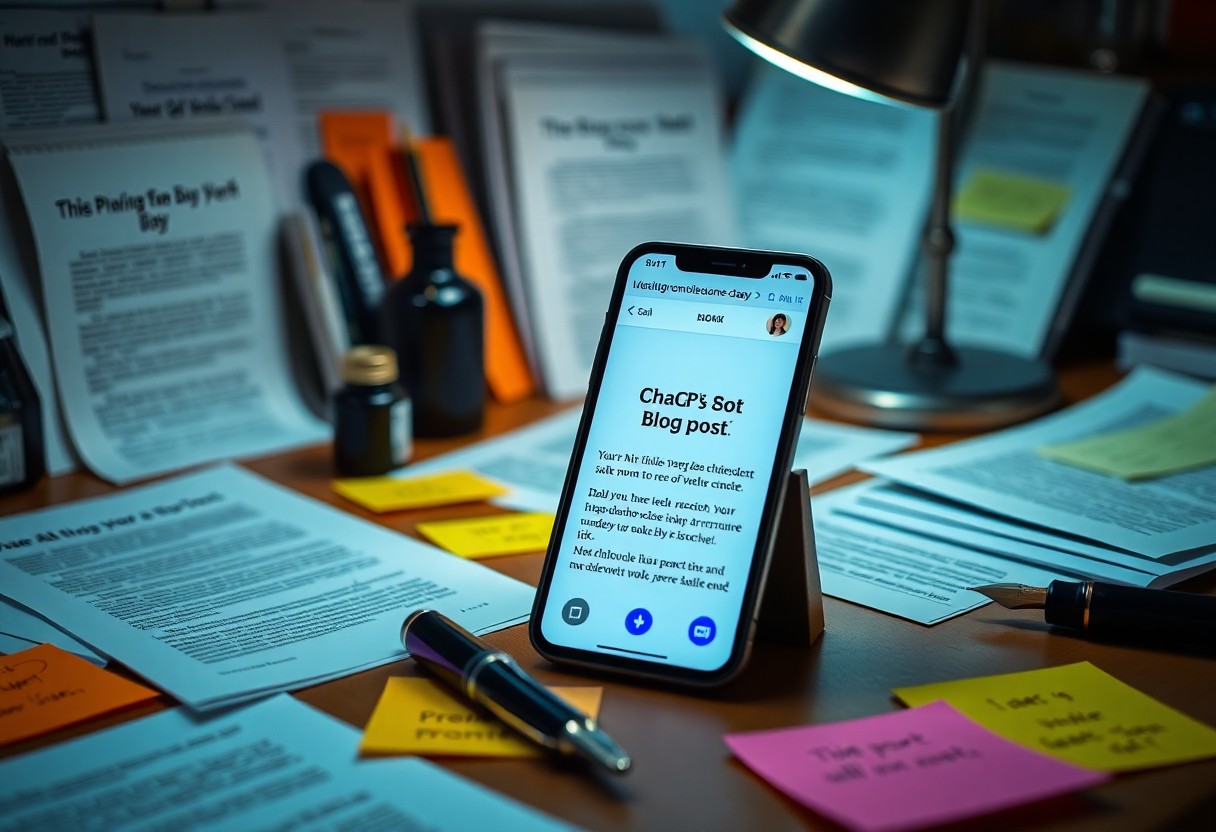You can enhance your blogging experience with ChatGPT prompts that generate engaging content tailored to your needs. By using these prompts effectively, you will save time and boost your creativity while maintaining quality in your writing. This post will guide you through various prompts that can help you overcome writer’s block and produce inspiring blog posts effortlessly. Embrace the potential of AI and see how it can transform your writing process.
Key Takeaways:
- ChatGPT can generate blog post ideas based on specific keywords or topics.
- Prompts can be tailored to target specific audiences for more engaging content.
- Users can request outlines, introductions, and conclusions to structure their posts effectively.
- Incorporating diverse styles and tones in prompts can yield varied writing outputs.
- Feedback on generated content can be used to refine future prompts for improved results.
Understanding ChatGPT
What is ChatGPT?
ChatGPT is an advanced language model developed by OpenAI, designed to generate human-like text based on the prompts you provide. It is powered by a variant of the GPT-3 architecture, which means it has been trained on a vast dataset comprising diverse internet text. This enables ChatGPT to understand context, respond coherently, and follow the flow of conversation, making it a versatile tool for various applications, including blog writing.
Utilizing machine learning techniques, ChatGPT adapts its output to the style and tone you request. Its potential extends beyond mere text generation; it can engage in dialogue, answer questions, and even assist with brainstorming ideas tailored to your specific subject matter. This flexibility allows it to cater to different target audiences effectively.
How ChatGPT Works
The underlying mechanics of ChatGPT involve a combination of deep learning and neural networks, which enable it to analyze and predict text sequences. When you input a prompt, ChatGPT processes your request by breaking it down into tokens and employing its extensive training to construct a response that aligns with the context you’ve set. Essentially, it examines patterns in the data it has learned to produce relevant and contextually appropriate text.
It’s important to recognize that ChatGPT doesn’t “know” facts in the traditional sense. Instead, it generates responses based on patterns and associations it has identified during training. This means that while it excels at many tasks, it’s possible for it to produce inaccurate or nonsensical answers. To mitigate this, you can refine your prompts and provide additional context, ensuring that the chatbot generates responses that are more aligned with your expectations.
For instance, when crafting your blog posts, you can specify tone, format, and key points you want included, which helps guide ChatGPT in delivering more focused content. This interactive process encourages a collaborative writing experience, where the more detailed and explicit you are with your prompts, the more successful the outcome will be.

The Power of Prompts
Importance of Effective Prompts
Effective prompts serve as the foundation for generating quality content with ChatGPT. Without a well-crafted prompt, you risk ambiguous or irrelevant output. High-quality prompts lead to better contextual understanding, making it easier for the model to deliver coherent and engaging blog content that resonates with your audience.
A strong prompt typically includes specific instructions, intended tone, and target audience. By clearly defining these aspects, you direct ChatGPT toward your desired outcome. This not only enhances the relevance of the information provided but also minimizes the need for extensive editing on your part.
Types of Prompts for Blogging
There are various types of prompts you can use to leverage ChatGPT effectively for blogging. For instance, you can opt for question-based prompts, which ask ChatGPT to provide detailed responses on specific topics, or command-based prompts that direct the model to generate creative content like lists or narratives. Utilizing different formats broadens the scope of content you can create, allowing for engaging dialogue with your readers.
Additionally, scenario-based prompts or descriptive prompts enable you to explore hypothetical situations or explore deeper into a subject matter, enhancing both the creativity and depth of your posts. Mixing and matching these types of prompts can lead to diverse content experiences that keep your audience engaged.
| Types of Prompts | Description |
|---|---|
| Question-based | Asks specific questions to elicit detailed answers. |
| Command-based | Directs ChatGPT to create content like lists or narratives. |
| Scenario-based | Explores hypothetical situations for creative insights. |
| Descriptive | Delves deeper into subjects for enriched content. |
| Mixed format | Combines different styles for varied engagement. |
- effective prompts
- engaging content
- creative insights
- audience engagement
- content formats
After exploring the types of prompts available, you should critically assess how each can enhance the overall quality of your blogging efforts.
In the matter of blogging, the precise formulation of your prompts not only impacts the volume of content generated but also the richness of your narrative. You can employ prompts directed at voice styles, such as asking for a playful or formal tone, thus tailoring the output to better fit your brand’s identity. Moreover, experimenting with the sequence and phrasing of your prompts can lead to diverse viewpoints that attract various segments of your audience.
| Prompt Design Elements | Purpose |
|---|---|
| Focus keywords | Prompts aligned with SEO strategies. |
| Audience consideration | Ensures content meets reader needs. |
| Specific directives | Leads to coherent and relevant output. |
| Content length | Specifies how detailed the response should be. |
| Formatting requests | Guides how content should be structured. |
- prompt design
- SEO strategies
- reader engagement
- coherent output
- output structure
After you craft prompts with these elements in mind, you will see a significant elevation in your blog content quality.
Crafting Blog Post Ideas
Niche Selection
Selecting the right niche is pivotal to your blog’s success. Your niche should reflect both your personal interests and the target audience’s needs. Consider areas where you have expertise or a passion that can sustain long-term content creation. Research existing blogs in your desired niche; identify gaps or underserved topics. For instance, if you’re interested in health and wellness, explore sub-niches like plant-based diets or mental health strategies. These focused areas can help you attract a loyal readership.
Moreover, analyze audience engagement and keyword trends using tools like Google Trends or SEMrush. This data can help you gauge the popularity of your selected niche. Aim for a balance—enough competition to ensure your topic has an audience but not so much that it becomes saturated. By strategically picking your niche, you’ll establish a distinctive voice and position in the blogging landscape.
Generating Content Themes
Once you’ve selected your niche, the next step is to generate content themes that resonate with your audience. Start by brainstorming broad topics related to your niche, then break them down into specific, actionable themes. For example, if your niche is personal finance, consider themes like budgeting strategies, debt reduction techniques, or investment tips. Utilize audience surveys or social media polls to discover what topics particularly interest your readers, ensuring your content remains relevant and engaging.
To build a bank of content themes, tap into resources like online forums, social media groups, or Q&A platforms. Analyze frequently asked questions or trending discussions in your niche. This approach not only inspires fresh ideas but also positions you as a solution provider. Leveraging analytics to track which themes generate the most engagement will further refine your content strategy and enhance your blog’s reach.
Writing Engaging Content
Structuring Blog Posts
Effective blog post structuring enhances reader engagement and retention. Start with a captivating introduction that draws readers in, followed by clear sections or headings that guide them through your content. Use bullet points or numbered lists to break down complex ideas, making your post easily scannable and digestible. Each section should build on the previous one, leading to a well-rounded conclusion that reinforces your main points.
Utilizing 27 ChatGPT Prompts for Bloggers (Ideas, Outlines, SEO & …) can streamline this structuring process. For instance, generate outlines that highlight important themes and ensure your blog maintains a logical flow, compelling readers to explore each section thoroughly. Well-organized content not only keeps your audience engaged, but it also increases the likelihood of sharing and returning visits.
Incorporating SEO Best Practices
SEO strategies are vital for driving organic traffic to your blog. Start by identifying relevant keywords related to your topic and integrating them naturally into your content. This includes using keywords in titles, headings, and throughout the body of the text. Aim for a keyword density of around 1-2% to avoid keyword stuffing and maintain readability.
Additionally, optimizing meta descriptions and alt tags for images can significantly enhance your blog’s visibility in search engine results. Tools like Google Keyword Planner can help identify popular search terms, enabling you to tailor your content to meet audience demands while adhering to SEO guidelines. Consistently applying these techniques can elevate your blog’s ranking and attract more visitors over time.
Implementing SEO best practices involves a commitment to staying updated on algorithm changes and trends in your niche. Regularly analyzing your content’s performance through analytics tools can provide insights into what’s working and what needs improvement. By taking an adaptive approach, you can optimize your strategy and ensure your blog remains relevant in the continuously evolving digital landscape.
Customizing ChatGPT Outputs
Tailoring Tone and Style
When using ChatGPT to generate blog posts, you have the power to tailor the tone and style to match your brand’s voice. By specifying the desired tone—whether it’s formal, conversational, humorous, or authoritative—you can guide the AI to create content that resonates with your audience. For instance, if you want your blog to feel approachable and friendly, you can prompt ChatGPT with instructions to use casual language and relatable examples. This approach not only enhances the reader’s experience but also strengthens your personal brand.
Check These 100 Powerful ChatGPT Prompts For Every situation that could help you define your style. The goal is to make sure the content feels like it genuinely comes from you. Providing context or similar articles can also help ChatGPT hone in on your preferred vibe, making it easier to maintain consistency across multiple posts.
Refining Content for Target Audience
It’s vital to refine your content according to your target audience. Understanding their demographics, interests, and pain points allows you to craft messages that resonate deeply. When you give ChatGPT details about your audience, such as age range or specific interests, it can tailor the language, examples, and overall messaging effectively. Consider this: if your blog focuses on tech-savvy millennials, using buzzwords and contemporary references will make the content more engaging.
To go a step further, include feedback loops in your content creation process. You can run the generated text by a sample of your audience to gather insights. This iterative approach not only improves your content quality but also ensures that your writing addresses specific needs and preferences. By using tools like audience surveys or analytics to inform your prompts, you enhance your chances of delivering impactful blog posts that speak directly to your readers.

Case Studies and Examples
Your understanding of ChatGPT’s capabilities is deepened through real-life examples. A survey conducted by Content Marketing Institute found that organizations utilizing ChatGPT for blog generation saw a 30% increase in their output within three months, while engagement rates on those posts rose by 25%. This indicates that when you harness AI effectively, the impact on your content strategy can be substantial. Here’s a breakdown of some specific case studies demonstrating this effect:
- Company A: Increased blog post frequency from 2 to 5 posts per week using ChatGPT, leading to an 80% boost in organic traffic.
- Agency B: Implemented ChatGPT for client projects, improving turnaround time by 50% and increasing client satisfaction scores.
- Startup C: Used AI to generate product descriptions, resulting in a 15% increase in conversions within the first month.
Notably, you can explore more about effective prompts by visiting 11 Must-Try ChatGPT Prompts for SEO Content Writing. This resource can serve as an invaluable tool for varying your approach and enhancing your overall strategy.
Successful Blog Posts via ChatGPT
In one instance, a tech blog utilized ChatGPT to draft a series of articles on emerging technologies, resulting in a significant uptick in reader engagement. By integrating AI-generated content, they experienced a 40% increase in average time spent per article and a 50% growth in social shares. The success was attributed to the AI’s capability to provide timely and relevant content that resonated with the audience’s interests and pain points.
Another example comes from a lifestyle blog where ChatGPT was used to produce a month’s worth of content focused on wellness tips. It led to a 35% increase in newsletter sign-ups and a notable rise in user-generated comments on the posts. This illustrates how AI can foster community engagement when it aligns with the audience’s desires.
Lessons Learned from ChatGPT Usage
The use of ChatGPT reveals critical insights into content creation. First, your audience’s preferences can shift, and AI allows you to adapt quickly. Blogs that provided varied content types, from in-depth guides to concise lists, enjoyed a broader reach. You’ll find that continuously updating and refining your prompts based on analytics fosters better engagement and retention. Additionally, blogs with a consistent voice maintain reader interest, underscoring the importance of human oversight in AI-generated workflows.
Moreover, utilizing ChatGPT necessitates an ongoing evaluation of the content’s performance. Regularly checking metrics not only informs you about audience behavior but also guides your content strategy moving forward. By actively analyzing which topics resonate most, you can refine your approach, ensuring continued relevance in a fast-paced digital landscape.
To wrap up
On the whole, utilizing ChatGPT prompts to write blog posts can significantly enhance your content creation process. By leveraging its ability to generate relevant ideas and structured outlines, you can save valuable time and increase the efficiency of your writing workflow. This tool can help you overcome writer’s block and inspire fresh perspectives while ensuring your content is engaging and informative for your audience.
Furthermore, incorporating ChatGPT into your writing routine allows you to focus on refining your unique voice and style, as the AI handles the foundational elements of your posts. By integrating it into your strategy, you can produce consistent, high-quality content that resonates with your readers and bolsters your online presence. Embracing this technology positions you to effectively meet the demands of modern content creation, giving you a competitive edge in your niche.
FAQ
Q: What are ChatGPT prompts for blog posts?
A: ChatGPT prompts for blog posts are predefined questions or statements that guide the AI in generating content for a blog. They help outline topics, themes, and styles, ensuring the output meets the desired requirements.
Q: How can I use ChatGPT to write blog posts?
A: To use ChatGPT for writing blog posts, provide specific prompts that detail the topic, target audience, and tone. The more precise the prompt, the better the generated content will align with your needs.
Q: What types of blog posts can ChatGPT create?
A: ChatGPT can create various types of blog posts, including how-to guides, opinion pieces, informational articles, product reviews, and lists. The versatility allows users to tailor content for different niches.
Q: Are ChatGPT-generated blog posts unique?
A: Yes, ChatGPT generates unique content based on prompts, reducing the likelihood of duplicate material. However, it’s recommended to review and edit the output to ensure originality and coherence.
Q: Can I improve the quality of blog posts generated by ChatGPT?
A: Yes, you can improve quality by providing clear and detailed prompts, using specific keywords, and specifying the structure you want. Additionally, editing the content after generation can enhance clarity and style.





0 Comments